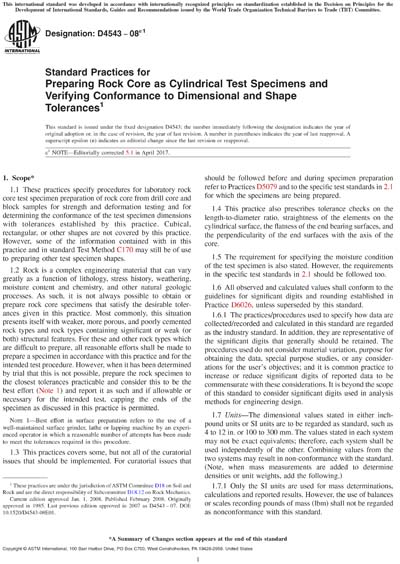Historical
ASTM D4543-08e1
Standard Practices for Preparing Rock Core as Cylindrical Test Specimens and Verifying Conformance to Dimensional and Shape Tolerances
1.1 These practices specify procedures for laboratory rock core test specimen preparation of rock core from drill core and block samples for strength and deformation testing and for determining the conformance of the test specimen dimensions with tolerances established by this practice. Cubical, rectangular, or other shapes are not covered by this practice. However, some of the information contained with in this practice and in standard Test Method C170 may still be of use to preparing other test specimen shapes.
1.2 Rock is a complex engineering material that can vary greatly as a function of lithology, stress history, weathering, moisture content and chemistry, and other natural geologic processes. As such, it is not always possible to obtain or prepare rock core specimens that satisfy the desirable tolerances given in this practice. Most commonly, this situation presents itself with weaker, more porous, and poorly cemented rock types and rock types containing significant or weak (or both) structural features. For these and other rock types which are difficult to prepare, all reasonable efforts shall be made to prepare a specimen in accordance with this practice and for the intended test procedure. However, when it has been determined by trial that this is not possible, prepare the rock specimen to the closest tolerances practicable and consider this to be the best effort (Note 1) and report it as such and if allowable or necessary for the intended test, capping the ends of the specimen as discussed in this practice is permitted.
1.3 This practices covers some, but not all of the curatorial issues that should be implemented. For curatorial issues that should be followed before and during specimen preparation refer to Practices D5079 and to the specific test standards in 2.1 for which the specimens are being prepared.
1.4 This practice also prescribes tolerance checks on the length-to-diameter ratio, straightness of the elements on the cylindrical surface, the flatness of the end bearing surfaces, and the perpendicularity of the end surfaces with the axis of the core.
1.5 The requirement for specifying the moisture condition of the test specimen is also stated. However, the requirements in the specific test standards in 2.1 should be followed too.
1.6 All observed and calculated values shall conform to the guidelines for significant digits and rounding established in Practice D6026, unless superseded by this standard.
Content Provider
ASTM International [astm]






